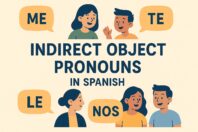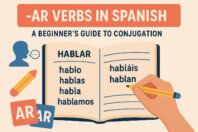Spanish Contractions: How and when to combine words in Spanish

Get our free email course, Shortcut to Conversational.
Have conversations faster, understand people when they speak fast, and other tested tips to learn faster.
More infoMastering contractions in Spanish is fundamental to sounding like a native speaker. By knowing and using Spanish contractions correctly, you’ll be able to sound less like a language learner and more like a natural speaker.
In today’s post, we’ll start with the main Spanish contractions al and del, and then move on to the other common contractions contigo and conmigo. We’ll round out our grammar lesson with an overview on combining object pronouns with verbs.
As a bonus, we’ll end with a list of very informal Spanish contractions that you won’t find in grammar books, but which are regularly heard in everyday speech in some Latin American countries.
So without further ado, let’s dive into the world of Spanish contractions!
Contractions in Spanish: Al and Del
You’re surely already familiar with contractions in English, because there are so many of them. Spanish, as well as French and numerous other languages, also make use of contractions.
By contractions, we’re referring to two words that are combined into one. In most cases this process involves dropping some letters, and in English you generally replace the missing letters with an apostrophe. Common contractions in English, for example, are “it’s,” “you’re,” “can’t,” or “won’t.” You also have informal contractions like “gonna,” “wassup,” or “y’all.”
In Spanish, the most important Spanish contractions are al and del. Unlike English, the Spanish contractions al and del do not take an apostrophe. They are simply the combination of:
- al: [the preposition a] + [the definite article el]
- del: [the preposition de] + [the definite article el]
In Spanish, contractions are not optional as in English, nor is it a matter of formality. Whenever you find the prepositions a or de before the definite article el, you must contract them. Otherwise, it’s grammatically incorrect.
- Ciro fue al cine porque quería ver la película de Flash. – Ciro went to the cinema because he wanted to watch the Flash movie.
- Nos encontramos en la entrada del bar. – We met up at the entrance of the bar.
Also, these contractions only work for the singular masculine pronoun el. Other articles such as la, los, and las are not contracted. For a full lesson on these words which all translate as the in Spanish, check out our dedicated post on Spanish articles. For a full lesson on prepositions beyond a and de, see our post on Spanish prepositions.
When and how to use Al in Spanish
In Spanish, al is used whenever the preposition a is followed by the definite article el. Let’s see the different contexts where we might encounter al in Spanish.
To express movement or destination
Similar to the English preposition to, the Spanish preposition a is used to indicate movement towards a place. When the place is of masculine gender, it requires the definite article el, so the preposition a combines with el to form the contraction al.
- Can you take me to the circus. – ¿Puedes llevarme al circo?
- Every Thursday they go to the gym. – Todos los jueves van al gimnasio.
- We’re going to the airport in an hour. – Vamos a ir al aeropuerto en una hora.
To refer to a location
We use the preposition a to talk about location, just as you use at in English. When followed by the article el, we need the contraction al.
- See you at the end of the road, my friend. – Nos vemos al final del camino, amigo.
- They’re going to wait for us at the foot of the mountain. – Nos van a esperar al pie de la montaña.
- The bank is next to the pharmacy. – El banco está al lado de la farmacia.
To refer to the end of a time period
We use the preposition a to indicate the end of a period of time. In English, this preposition can be translated as until or to.
- Martita is going to be here from this Monday to the following Friday. – Martita va a estar aquí desde el lunes al viernes que viene.
- From today until next month, there’ll be no more shows. – Desde hoy al mes próximo, no habrá más shows.
- Valid only until January 20th, 2024. – Solo válido al 20 de enero de 2024.
To introduce an indirect object
Many Spanish verbs use the preposition a to introduce the indirect object, to say to whom the action is being directed. Where the indirect object is a singular masculine noun that would have the article el, we need to use the Spanish contraction al instead of “a el.”
- Juan gave the package to the courier. – Juan entregó el paquete al mensajero.
- The boy threw the ball to the dog. – El niño le lanzó la pelota al perro.
- The teacher explained the lesson to the student. – La profesora explicó la lección al estudiante.
If you need a refresher on direct or indirect objects in Spanish, we explain them in our dedicated post on direct and indirect object pronouns.
When and how to use Del in Spanish
In Spanish, del is used when the preposition de is followed by the definite article el. Now let’s look at the different situations where we’ll see del in Spanish.
To express origin
When discussing a place of origin, the preposition de is used to say that someone or something is from there. Where the place is a masculine noun, this requires the use of the contraction del.
- Pedro is from the south of Argentina. – Pedro es del sur de Argentina.
- The chocolates are from the best town in Switzerland. – Los chocolates son del mejor pueblo de Suiza.
For more vocab on talking about where people are from, check out our posts on Spanish-speaking countries, and on nationalities in Spanish.
To express possession
In Spanish, we often express possession using de + article, similarly to your less-common English construction using of the. Where the article would be el, we use the contraction del. The English version sometimes works with of the, though your best translation often relies on simply adding ’s to the noun.
- This is the day of the gym teacher. – This is the gym teacher’s day. – Este es el día del maestro de gimnasia.
- These are the grades of the best student. – These are the best student‘s grades. – Estas son las notas del mejor alumno.
To refer to the beginning of a time period
Our del contraction in Spanish is frequently used to talk about a starting point in time. In English, you typically express this same meaning using from, starting from, or as of.
- We’re going on vacation from the 1st to the 15th of January. – Nos vamos de vacaciones del 1 al 15 de enero.
- The tests will be held from Monday the 3rd to Wednesday the 5th. – Los exámenes serán del lunes 3 al miércoles 5.
We cover this and more in our post on how to talk about dates in Spanish. If you just want the vocab, you can refer to our post on the names of days, months, and seasons in Spanish.
When not to use the contractions Al and Del in Spanish
There are a couple of exceptions when the Spanish contractions al and del should not be used.
When the article El is part of a name
When we refer to proper nouns that start with El as part of their name, we cannot contract “de El” or “a El.” This is common for works of art, books, and movies, as well as for many geographical names such as cities.
- We’re going on vacation to El Calafate, in Argentina. – Nos vamos de vacaciones a El Calafate, en Argentina.
- My aunt is traveling to El Salvador for Easter. – Mi tía viaja a El Salvador para Semana Santa.
- Pablo Picasso is the painter of «El Guernica». – Pablo Picasso es el pintor de «El Guernica».
When Él is a personal pronoun
Hopefully you already know that él with an accent is not the same as el without the accent. The accented version of él is the personal pronoun which can be translated as he or him in English, whereas the unaccented version is the definite article the in English. This may be less problematic in written texts, but be careful while speaking!
- This computer is his. – Esta computadora es de él.
- We all gave the gift to him. – Todos le dimos el regalo a él.
The other common contractions in Spanish: Conmigo, Contigo, Consigo
Another obligatory contraction in Spanish occurs when the preposition con is used with the prepositional pronouns mí, ti, or sí. In this case, the contraction becomes conmigo, contigo, or consigo. Note that although mí and sí have accents, the resulting contractions are unaccented.
The preposition con in Spanish means with. Thus, conmigo means with me, and contigo means with you. We go into a lot more detail on these Spanish contractions in our dedicated post on conmigo and contigo.
- Will you come on a trip with me? – ¿Quieres venir de viaje conmigo?
- This clothing does not suit you. – Esa vestimenta no va contigo.
Consigo can have several different meanings, because sí can act as the third-person prepositional reflexive pronoun in both singular and plural. Since sí can therefore refer back to él, ella, usted, ellos, ellas, or ustedes, consigo can be translated as with himself, with herself, with yourself, with themselves, or with yourselves.
- Don’t forget to bring all your belongings with you, sir. – No olvide traer consigo todas sus pertenencias, señor.
- Guys, don’t forget to bring your passports with you. – Chicos, no olviden traer los pasaportes consigo.
If we really want to emphasize the fact that the person is doing something themself, we can add mismo to any of these contractions. Conmigo mismo would translate as with myself and contigo mismo as with yourself. Consigo can represent different third-person pronouns, so the important thing to remember with consigo mismo is that there’s the added ‑self in the translation.
- He won’t stop speaking to himself. – No deja de hablar consigo mismo.
- They are so lost in life that they don’t know what to do with themselves. – Están tan perdidos en la vida que no saben qué hacer consigo mismos.
We’ve included consigo in this lesson since it’s indeed one of the few true Spanish contractions, but in reality, this word is used very infrequently. We go deeper on the use of sí as a prepositional reflexive pronoun in our post on sí vs si.
Combining verbs and object pronouns
So far we’ve taken a deep look at the five official Spanish contractions, where two words are combined into one by dropping some letters. Before we move on to our informal Spanish contractions, let’s just take a moment to look at the other instance where we combine words in Spanish: when adding object pronouns to the end of verbs.
Technically, these aren’t considered contractions, because we don’t drop any letters in the process. We’ll mention them here anyway, since they’re still examples of combining words in Spanish. We have detailed lessons on each of these cases, so please refer to those posts for more details.
Note that in most cases, adding pronouns to the end of a verb will also trigger the need to add an accent to the verb. We explain the rules behind this in our posts on Spanish syllables and on accents in Spanish. For now, let’s just cover the main contexts where we combine verbs and pronouns.
Adding a direct object pronoun to an infinitive
We frequently use Spanish infinitives in a sentence after other conjugated verbs. This can be to express certain actions like wanting to or needing to, to express obligation using hay que or tener que, to express immediate past or future using acabar de or ir a, or a number of other contexts. In any of these situations, when the action takes a direct object pronoun, it gets attached to the infinitive.
- Did you write your essay? You need to finish it today. – ¿Escribiste tu ensayo? Tienes que terminarlo hoy.
- Julio caught three fish. Should we cook them on the campfire? – Julio pescó tres peces. ¿Deberíamos cocinarlos en la fogata?
Adding a direct object pronoun to the gerund when using the progressive form
Present progressive Spanish is used to talk about what is happening at the moment of speaking by using a gerund, which is similar to the English -ing form. The object pronoun is added to the gerund, and not to the conjugated form of estar which precedes it.
- My essay is almost finished. I’m writing it now. – Mi ensayo casi está terminado. Estoy escribiéndolo ahora.
- The fish smell delicious. Dad is cooking them now. – Los pescados huelen deliciosos. Papá está cocinándolos ahora.
Adding the direct object pronoun to the affirmative imperative conjugation when giving orders
We cover this sentence structure in our posts on the imperative tense, informal commands, and formal commands.
- Your essay is due today. Finish it now! – Tu ensayo debe entregarse hoy. ¡Termínalo ahora!
- These fish are ready. Serve them to your brothers. – Estos pescados están listos. Sírvelos a tus hermanos.
Adding indirect object pronouns to verbs
The same rules we just saw with direct object pronouns also apply to indirect object pronouns. In some cases we even add both an indirect object pronoun and a direct object pronoun to the same verb, always in that order.
- The teacher is waiting for your essay. Give it to him before you leave. – El profesor está esperando tu ensayo. Dáselo antes de irte.
- These fish are for your brothers. Serve them to them. – Estos pescados son para tus hermanos. Sírveselos.
Adding reflexive pronouns to verbs
So far in this section we’ve just focused on direct and indirect object pronouns. The same rules apply to reflexive pronouns, whether we’re using reflexive verbs, or whether we’re just describing some other action being carried out on the subject.
- You need to wake yourself up early. – Tienes que despertarte temprano.
- I’m waking myself up now. – Estoy despertándome ahora.
- Wake yourself up earlier! – ¡Despiértate más temprano!
Informal contractions in Spanish
Informal contractions in Spanish are commonly used in spoken language and informal settings. They are often used to simplify pronunciation or to speed up speech.
Here we present you with some informal Spanish contractions that you’ll often hear throughout Latin America. Many of them even appear in this video, where Mafalda gives some top tips on how to sound more like a native speaker.
These should only be written when transcribing spoken Spanish phonetically! Otherwise, the full words should be written out, rather than actually writing these informal spoken contractions.
Para Spanish contraction: Pa’
The preposition para in Spanish is commonly contracted into pa’ when followed by adverbs or pronouns.
| Informal Spanish Contraction | Full Phrase | English |
| Pa’qué | Para qué | What for, For, In order to |
| Pa’ca | Para acá | Here, Over here |
| Pa’llá | Para allá | There, Over there |
| Pa’ti | Para ti | For you |
| Pa’mí | Para mí | For me |
| Pa’dentro | Para adentro | Inside |
| Pa’fuera | Para afuera | Out, Outside |
| Pa’rriba | Para arriba | Up, Upstairs |
| Pa’bajo | Para abajo | Down, Downstairs |
- Messi said angrily: “Go over there, silly.” – Messi dijo enojado: «Andá pa’lla bobo». [para allá]
- Are these flowers for me? – ¿Estás flores son pa’mí? [para mí]
- Let’s go down! – ¡Vamos pa’bajo! [para abajo]
One of these expressions is even used in a popular expression to accompany beer drinking in Spanish, with pa’dentro [para adentro] essentially translating as down the hatch. When the whole group is ready to down their drinks at the same time, everyone chants arriba, abajo, al centro y pa’dentro together, moving their glasses along with the instructions: up, down, to the center, and down the hatch!
Other informal Spanish contractions
Some speakers also contract word pairs such as donde es, de esto/a, or entre ambos. It’s also common to simply shorten some conjugations of the verb estar.
- Where’s the bathroom? – ¿Onde’s el baño? [Donde es]
- I’m not going to talk about this. – Desto no voy a hablar. [De esto]
- Between the two of them, the friends made the movie. – Entrambos amigos hicieron la película. [Entre ambos]
- Here you are! – ¡Acá tás! [estás]
Mijo and Mija
We’ll end our list of Spanish contractions with a couple of sweet ones: mijo and mija. These are shortened forms of mi hijo and mi hija in Spanish, meaning my son and my daughter. They’re not just used between parents and their kids though! These affectionate contractions in Spanish are rather used as terms of endearment between loved ones, friends, and immediate family members.
- I made you your favorite smoothie, sweetie. – Te hice tu batido favorito, hijo.
- Come give me a kiss on the cheek, cutie pie. – Ven y dame un beso en la mejilla, hija.
These two informal contractions are such popular pet names that we have a full post on the various mijo and mija meanings in Spanish.
Conclusion: Spanish contractions
So far so good! We’ve gone through the whole range of contractions in Spanish.
In this post we presented you with a detailed guide on how to use the five official Spanish contractions al, del, conmigo, contigo, and consigo, so you always say and write them correctly. In addition, we gave an overview of cases where Spanish verbs combine with object pronouns.
We also included some common informal contractions that every native Spanish speaker says on the streets of Latin America, since you’re bound to hear some of these shortened words in the spoken language!
Exercises
Take a look at the following sentences. Based on your new knowledge of Spanish contractions, correct the ones that need to be corrected.
1. Este carro es de él.
2. El agua de el termo está fría.
3. Sergio va todos los días a El País, allí trabaja.
4. Venimos de el mecánico.
5. Voy a ir a la playa con ti.
6. «Vamos a ir par’dentro pronto.»
7. Ya le dimos la propina a el mesero.
Answers
1. Correct: Este carro es de él. – This car is his.
2. Incorrect: El agua del termo está fría. – The water in the thermos flask is cold.
3. Correct: Sergio va todos los días a El País, allí trabaja. – Sergio goes to El País every day. That’s where he works.
4. Incorrect: Venimos del mecánico. – We’re coming from the mechanic’s.
5. Incorrect: Voy a ir a la playa contigo. – I’m going to go to the beach with you.
6. Incorrect: «Vamos a ir pa’dentro pronto.» – “We’re going inside soon.”
7. Incorrect: Ya le dimos la propina al mesero. – We already gave the tip to the waiter.



